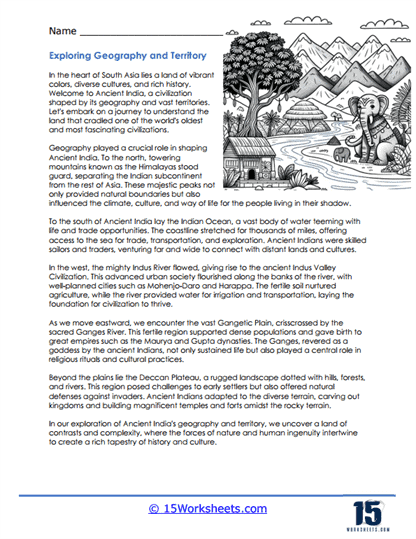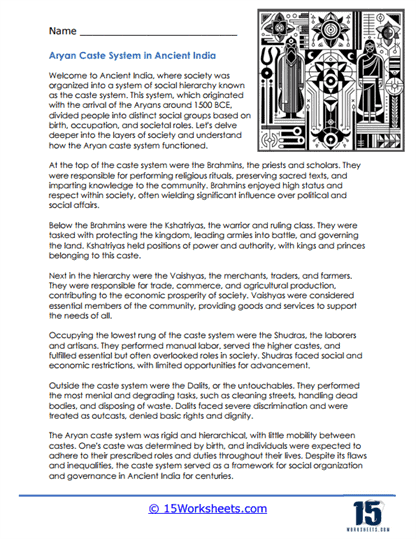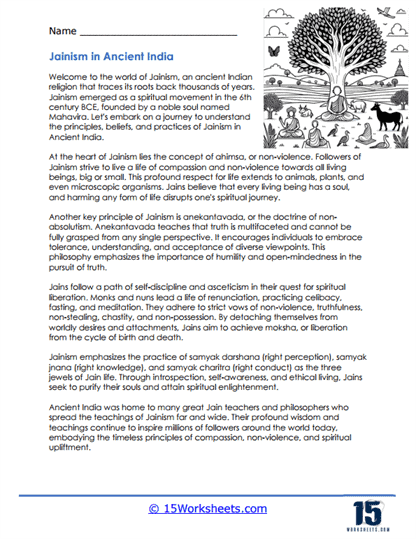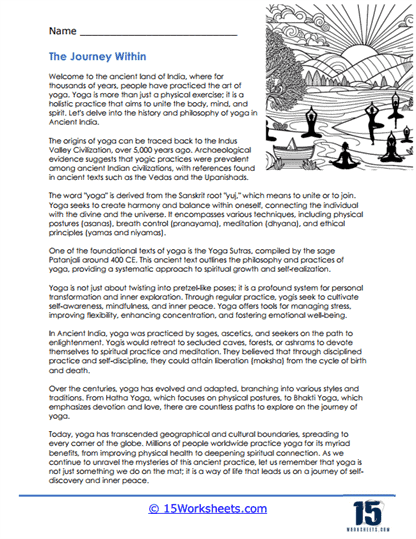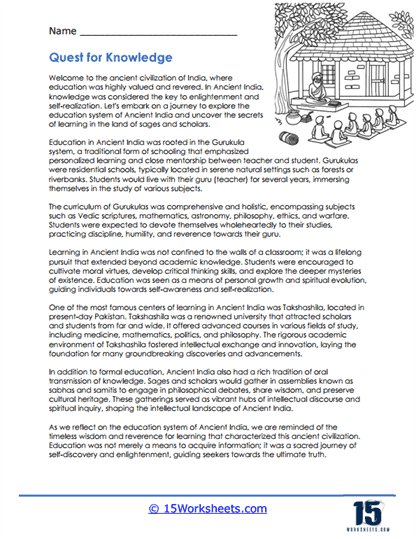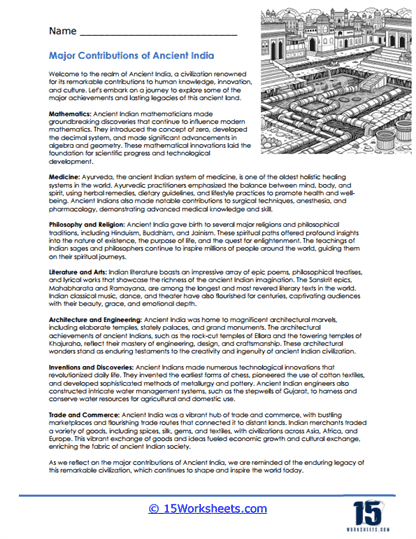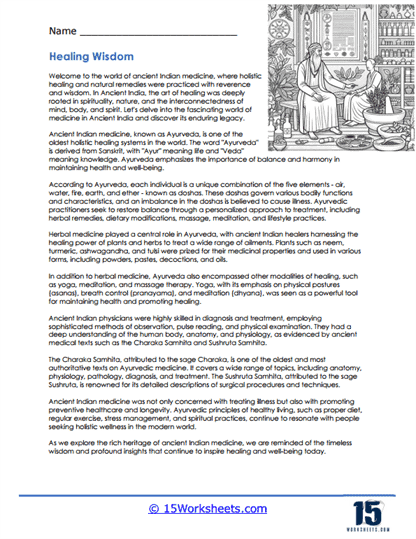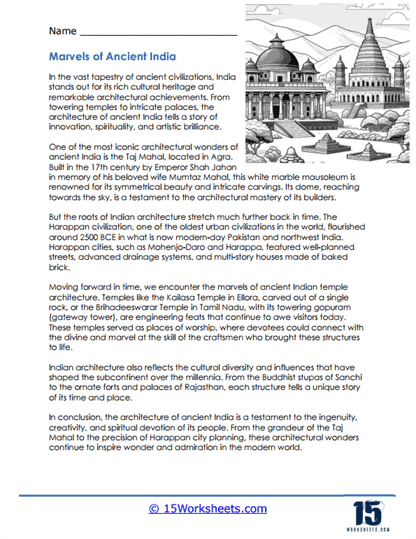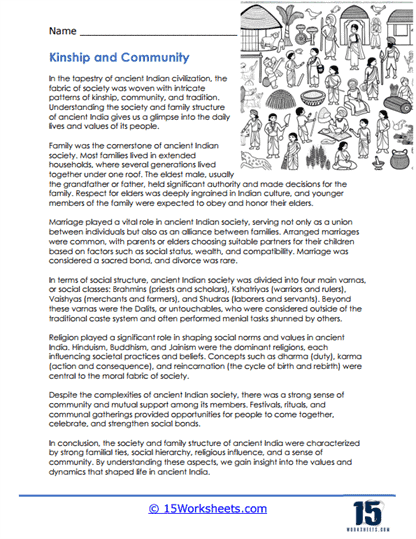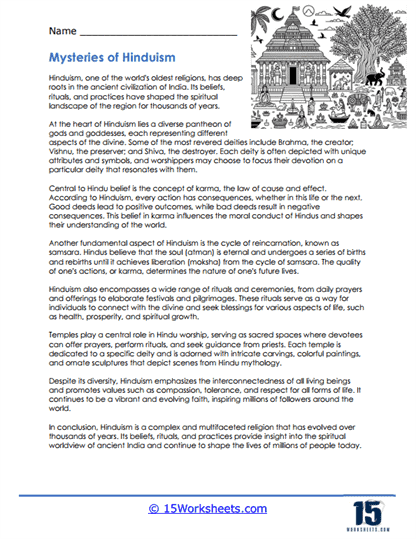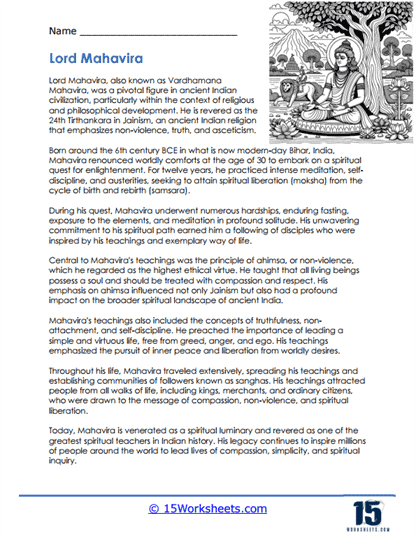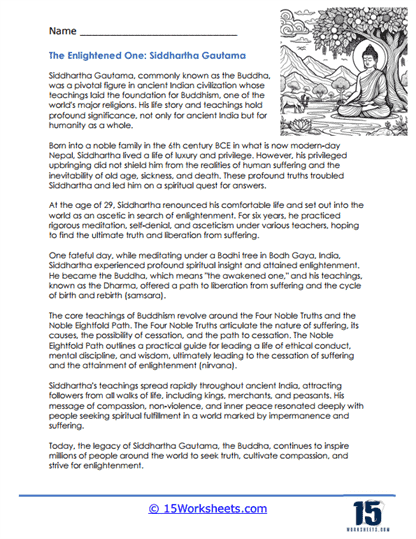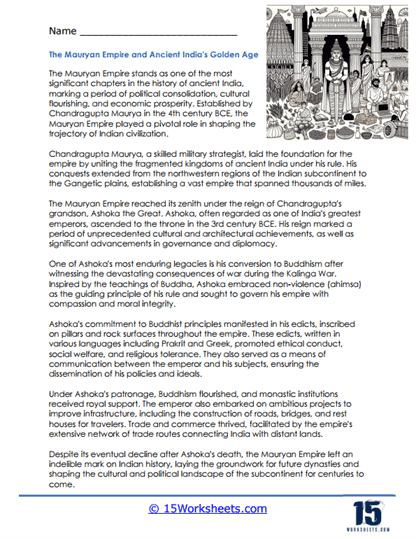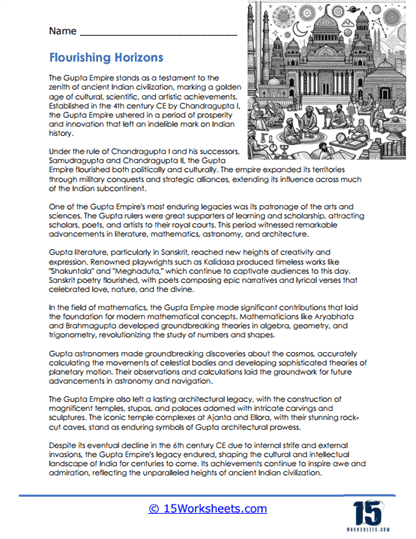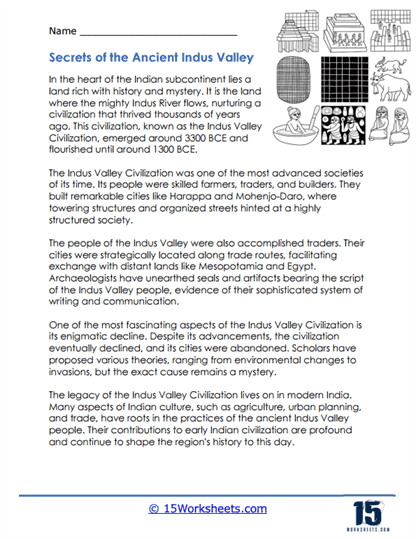Ancient India Worksheets
About These 15 Worksheets
Our collection of worksheets can be used to help enhance students’ understanding of the rich history and diverse culture of Ancient India, a civilization that dates back over 5,000 years and has contributed significantly to world heritage. The subject of Ancient India is vast and intricate, encompassing the Indus Valley Civilization, the Vedic Age, the Maurya and Gupta Empires, and many other aspects of early Indian culture, science, and philosophy.
Types of Exercises
Timeline Construction – Timelines are a staple exercise that encourages students to sequence historical events, helping them understand the chronology of India’s history and the progression of its civilizations. These exercises ask students to identify and label geographical features relevant to Ancient India, such as the Indus River, the location of historical sites like Mohenjo-Daro and Harappa, or the extent of various empires. Students might also map trade routes, showing how India connected with other regions.
Reading Comprehension Passages – Students read about topics such as the caste system, the life of Gautama Buddha, the reign of Ashoka, or the advancements in science and mathematics. Questions following the passages test students’ understanding and critical thinking about the texts.
Fill-in-the-Blanks – These are useful for reinforcing key vocabulary and concepts. Students might complete sentences with words related to Hinduism, Buddhism, ancient dynasties, or cultural innovations from the worksheet’s content.
Matching Exercises – Students might match terms with definitions or descriptions with their corresponding historical figures or events, such as matching “sati” with its practice or “Chandragupta Maurya” with the Mauryan Empire.
Multiple-Choice and True/False Questions – These exercises provide a straightforward assessment of students’ recall and understanding of factual information. Students articulate their understanding in their own words, delving deeper into topics such as the significance of the Vedas or the impact of the Silk Road.
Discussion and Debate Prompts – Students might debate the merits of the caste system or discuss the impact of Ancient Indian culture on modern society, which promotes higher-level thinking and articulation.
Art and Craft Projects – To explore the cultural aspect, students may recreate Ancient Indian art, such as Rangoli patterns, or build models of famous architectural sites like the stupa at Sanchi.
Role-Playing and Dramatization – Students could enact historical scenarios like a scene from a day in the life of a person during the Gupta Empire or simulate a trading negotiation at an ancient port, deepening their empathetic understanding of historical contexts.
Compare and Contrast Activities – Such exercises might involve comparing Ancient Indian governance with that of other contemporary civilizations, enhancing comparative analysis skills.
The Benefits of These Worksheets
These worksheets help students in various ways, not only academically but also in their personal growth as learners and members of a global community.
Enhancing Knowledge of World Civilizations – These worksheets offer students an extensive look into one of the world’s oldest civilizations, enabling them to understand the foundations of modern culture and society.
Developing Critical Thinking and Analysis – The variety of exercises on Ancient India worksheets challenges students to think critically about historical narratives, causes and effects, and the development of cultural and scientific achievements.
Increasing Cultural Awareness – Through in-depth study of Ancient India’s beliefs, practices, and contributions to fields like mathematics and astronomy, students gain a deeper appreciation for diverse cultures and the interconnectedness of human history.
Building Contextual Understanding – Activities that involve mapping, timelines, and role-play allow students to place historical events and cultural developments in context, which is crucial for understanding how past societies functioned and evolved. Reading passages about Ancient India and answering questions improve literacy skills, including comprehension, inference, and the ability to summarize complex texts.
Strengthening Communication Skills – Discussions, debates, and essay writing require students to articulate their thoughts clearly and effectively, which is valuable for all areas of study and communication in daily life. Worksheets with puzzles and matching exercises are particularly effective for younger students to remember key terms and concepts.
Cultivating Empathy – Role-playing exercises foster an empathetic understanding of what life might have been like for individuals in Ancient India, allowing students to connect with history on a personal level. Engaging with the vast array of topics related to Ancient India stimulates students’ curiosity about history, religion, philosophy, and science, encouraging lifelong learning.
Encouraging Independent Research – Many worksheet activities encourage further investigation, such as researching a specific empire or cultural practice, which fosters independent learning and research skills.
What Was the Ancient India Civilization?
Ancient India, or the Indian subcontinent, is a region that boasts one of the world’s oldest and most influential civilizations. Its history is marked by the diversity of its cultures, languages, and religious traditions. The term often specifically refers to the periods from the prehistoric cultures of the Stone Age to the end of the ancient period, which is conventionally marked by the onset of the early medieval period around 500 CE.
Civilization’s Development
The earliest known urban culture of the subcontinent is the Indus Valley Civilization, which flourished around 2500 BCE in what is now Pakistan and northwest India. Known for its advanced urban planning, it had well-laid-out cities like Harappa and Mohenjo-Daro with sophisticated sewage and drainage systems, granaries, and citadels.
Following the decline of the Indus Valley Civilization, the Vedic period began, marked by the composition of the early texts known as the Vedas. These religious and philosophical texts would lay the groundwork for the diverse spiritual traditions of Hinduism.
As the Vedic period transitioned into the later historic periods, large empires began to form, most notably the Maurya and Gupta empires. These periods saw significant developments in art, science, and culture and are often considered the Golden Age of India.
Way of Life
Agriculture was the backbone of economic life in ancient India, with the society largely being agrarian. The main crops included staples like wheat, barley, and rice. Beyond farming, the civilization also saw the rise of urban centers where trade and crafts flourished, facilitated by advancements in technology and infrastructure.
The caste system, which categorized society into hierarchical groups based on occupation and birth, played a significant role in everyday life, determining one’s profession, social circle, and marriage prospects. This system is detailed in the Manusmriti, an ancient legal text that also provides insights into the laws and societal norms of the times.
Religion and Philosophy
The spiritual life in ancient India was diverse and gave birth to four of the world’s major religions – Hinduism, Buddhism, Jainism, and Sikhism. Hinduism, with its multitude of deities and rituals, influenced daily life profoundly. Buddhism and Jainism emerged as reactions to the prevailing Hindu order, advocating for paths of renunciation, non-violence, and self-discipline.
Contributions to Humanity
Philosophy and Religion – Ancient India’s contributions in the realms of spirituality and philosophy are monumental. The Upanishads, part of the later Vedas, contain some of the earliest discussions of concepts like karma, dharma, the atman (soul), and moksha (liberation).
Mathematics – The decimal system, the concept of zero, and place value notation were significant mathematical innovations from ancient India. Mathematicians like Aryabhata and Brahmagupta made foundational contributions to algebra and trigonometry.
Science – Ayurveda, an ancient system of medicine, is still in practice today. The texts Charaka Samhita and Sushruta Samhita are considered cornerstones of this practice, offering detailed insights into surgery and plant-based remedies.
Astronomy – Ancient Indian astronomers could calculate the occurrence of eclipses, the Earth’s circumference, and had a strong understanding of celestial phenomena, as evidenced by texts such as the Aryabhatiya.
Literature and Arts – Sanskrit literature, including epics like the Mahabharata and Ramayana, has deeply influenced storytelling and literary conventions. Classical arts, music, dance, and drama, such as Bharatanatyam and Kathak, also have roots in this period.
Architecture – Architectural marvels from ancient India, such as the stupa at Sanchi and the rock-cut caves of Ajanta and Ellora, are UNESCO World Heritage Sites today. These structures showcase the intricate artistry and engineering prowess of the time.
Language and Linguistics – The grammarian Panini composed the Ashtadhyayi, a foundational text that analyzes the structure of Sanskrit and forms the basis for modern linguistic theory.
Political Science – The Arthashastra by Kautilya (also known as Chanakya) is a treatise on statecraft, economic policy, and military strategy, which is still studied in the context of governance and political science.
The way of life in ancient India, with its complex social structure, rich spiritual traditions, and profound intellectual achievements, has shaped the course of human history and continues to influence modern society across various dimensions. The legacies of ancient India’s philosophical thought, scientific knowledge, literature, and arts persist, illustrating the civilization’s enduring impact on humanity.

